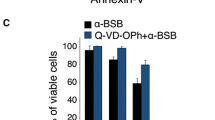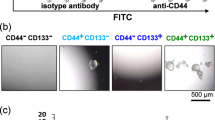Abstract
The anti-proliferative effects of pivaloyloxymethyl butyrate (AN-9), a butyric acid (BA) derivative with potent tumor-differentiating properties both in vitro and in vivo, was evaluated against colorectal, breast, lung, ovarian, renal cell, bladder, and other types of tumor colony-forming units in a human tumor cloning assay. A total of 76 evaluable specimens were exposed to AN-9 continuously, 48 of these were also exposed to BA continuously for direct comparison of the two agents, and 20 specimens were exposed to AN-9 for two hours. An in vitro inhibitory response was defined as a ≥ 50% decrease in tumor colony formation in treated cells compared to untreated controls. Superior anti-tumor activity was observed with the continuous exposure to AN-9 (39% in vitro response at 100 μM and 70% at 200 μM) than with the two-hour exposure (20% at 100 μM and 25% at 200 μM). At a continuous concentration of 200 μM, AN-9 demonstrated greater tumor-specific activity than BA against melanoma (100% vs. 67%), ovarian (67% vs. 40%), breast (63% vs. 0%), non-small cell lung (60% vs. 10%), and colorectal tumor colony-forming units (62% vs. 20%). AN-9 is a novel differentiating agent with activity against colony-forming units derived from a variety of primary human tumors, including those that are considered relatively chemoresistant, and may thus provide a therapeutic alternative or addition to standard cytotoxic agents, if appropriate drug concentrations can be achieved in patients.
Similar content being viewed by others
References
Rephaeli A, Rabizadeh E, Aviram A, Shaklai M, Ruse M, Nudelman A: Derivatives of butyric acid as potential antineoplastic agents. Int J Cancer 49: 66–72, 1991
Rabizadeh E, Shaklai M, Nudelman A, Eisenbach L, Rephaeli A: Rapid alteration of c-mycand c-junexpression in leukemic cells induced to differentiate by a butyric acid prodrug. FEBS Lett 328: 225–229, 1993
Zimra Y, Wasserman L, Maron L, Shaklai M, Nudelman A, Rephaeli A: Butyric acid and pivaloyloxymethyl butyrate, AN-9, a novel butyric acid derivative, induce apoptosis in HL-60 cells. J Cancer Res Clin Oncol 123: 152–160, 1997
Aviram A, Zimrah Y, Shaklai M, Nudelman A, Rephaeli A: Comparison between the effect of butyric acid and its prodrug pivaloyloxymethyl butyrate on histones hyperacetylation in an HL-60 leukemic cell line. Int J Cancer 56: 906–909, 1994
Nudelman A, Ruse M, Aviram A, Rabizadeh E, Shaklai M, Zimrah Y, Rephaeli A: Novel anticancer prodrugs of butyric acid. J Med Chem 35: 687–694, 1992
Hamburger AW, Salmon SE: Primary bioassay of human tumor stem cells. Science 197: 461–463, 1977
Salmon SE, Hamburger AW, Soehnlen B, Durie BG, Alberts DS, Moon TE: Quantitation of differential sensitivity of human tumor stem cells to anticancer drugs. N Engl J Med 298: 1321–1327, 1978.
Von Hoff DD: He's not going to talk about in vitropredictive assays again, is he? J Natl Cancer Inst 82: 96–101, 1990
Von Hoff DD, Clark GM, Stogdill BJ, Sarosdy MF, O'Brien MT, Casper JT, Mattox DE, Page CP, Cruz AB, Sandbach JF: Prospective clinical trial of a human tumor cloning system. Cancer Res 43: 1926–1931, 1983
Shoemaker RH, Wolpert-Defillipes MK, Kern DH, Lieber MM, Makuch RW, Melnick NR, Miller WT, Salmon SE, Simon RM, Venditti JM, Von Hoff DD: Application of a human tumor colony-forming assay to new drug screening. Cancer Res 45: 2145–2153, 1985
Hanauske U, Hanauske AR, Marshall MH, Muggia VA, Von Hoff DD: Biphasic effects of vanadium salts on in vitrotumor colony growth. Int J Cell Cloning 5: 170–178, 1987
Rowinsky EK, Donehower RC: Drug therapy: Paclitaxel (Taxol). N Engl J Med 332: 1004–1114, 1995
Koeffler HP: Induction of differentiation of human acute myelogenous leukemia cells: therapeutic implications. Blood 62: 709–721, 1983
Novogrodsky A, Dvir A, Ravid A, Shkolinik T, Stenzel KH, Rubin AL, Zaizov R: Effect of polar organic compounds on leukemic cells: butyrate-induced reduced partial remission of acute myelogenous leukemia in a child. Cancer 51: 9–14, 1983
Miller AA, Kurschel E, Osieka R, Schmidt C: Clinical pharmacology of sodium butyrate in patients with acute leukemia. Eur J Cancer Clin Oncol 23: 1283–1287, 1987
Aviram A, Rephaeli A, Shaklai M, Nudelman A, Ben-Dror I, Maron L, Rabizadeh E: Effect of the cytostatic butyric acid pro-drug, pivaloyloxymethyl butyrate, on the tumorigenicity of cancer cells. J Cancer Res Clin Oncol 123: 267–271, 1997
Author information
Authors and Affiliations
Rights and permissions
About this article
Cite this article
Siu, L.L., Von Hoff, D.D., Rephaeli, A. et al. Activity of pivaloyloxymethyl butyrate, a novel anticancer agent, on primary human tumor colony-forming units. Invest New Drugs 16, 113–119 (1998). https://doi.org/10.1023/A:1006049227744
Issue Date:
DOI: https://doi.org/10.1023/A:1006049227744




